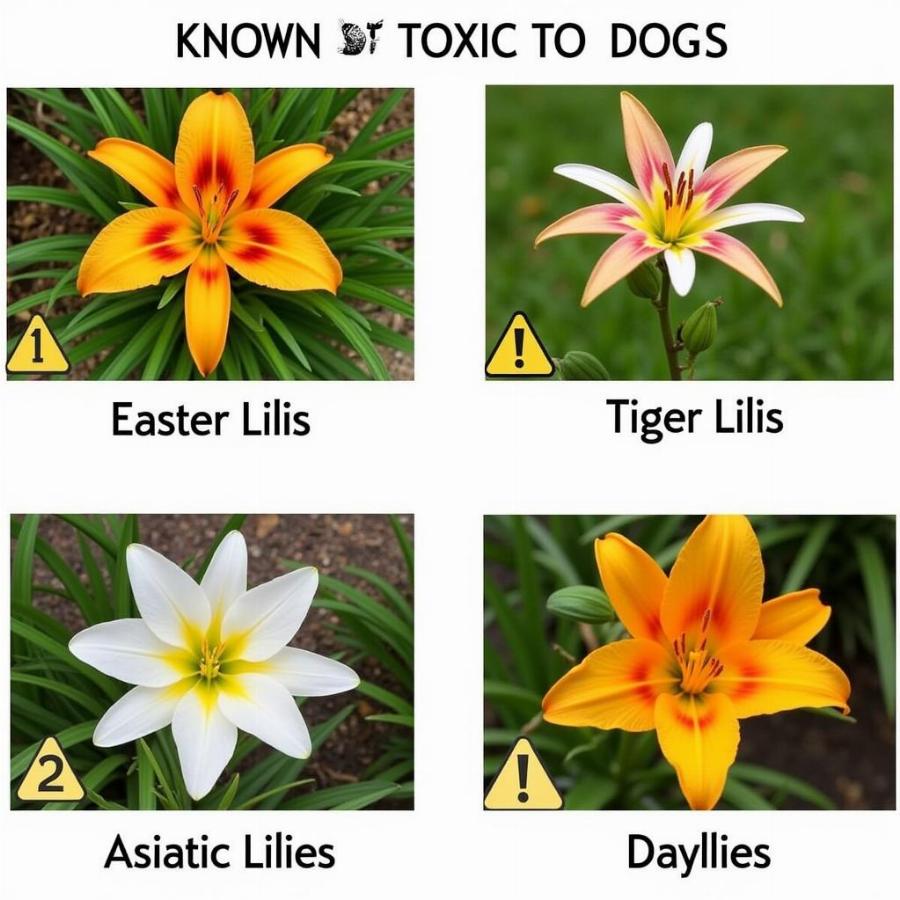Lilies are beautiful, fragrant flowers, a popular choice for bouquets and gardens. But are lilies dangerous to dogs? The answer is a resounding YES. For dog owners, lilies pose a serious threat, and understanding the dangers is crucial for keeping your furry friend safe. Exposure to even small amounts of certain lily varieties can lead to severe kidney failure in dogs. This isn’t just a mild upset stomach; we’re talking about a life-threatening condition.
Why Are Lilies Toxic to Dogs?
The specific toxin in lilies that causes kidney failure in dogs remains unidentified. However, all parts of the lily plant are considered poisonous: the petals, leaves, stem, pollen, and even the water in a vase holding lilies. Ingestion is the most common route of exposure, but dogs can also be affected by licking pollen off their fur after brushing against the flowers. Even tiny amounts of ingested lily plant material can have devastating effects.
Which Lilies Are Most Dangerous?
While all lilies are considered toxic to cats, certain types pose a more significant threat to dogs. The “true lilies” belonging to the Lilium and Hemerocallis genera are especially dangerous. This includes popular varieties like Easter lilies, Tiger lilies, Asiatic lilies, Daylilies, and Japanese Show lilies. Even a small amount of exposure, such as two or three petals or leaves, or even the pollen, can cause serious poisoning.
After the first paragraph of introduction.
lilies and dogs
Signs of Lily Poisoning in Dogs
Recognizing the symptoms of lily poisoning is critical for prompt treatment. Early signs, which can appear within hours of exposure, often include vomiting, lethargy, loss of appetite, excessive drooling, and increased thirst or urination. As the condition progresses, symptoms can worsen to include dehydration, disorientation, and seizures. If you suspect your dog has ingested any part of a lily, seek immediate veterinary attention.
What to Do If Your Dog Eats a Lily
Time is of the essence if your dog has ingested any part of a lily. First, remove any remaining plant material from your dog’s reach. Do not induce vomiting unless instructed by a veterinarian. Contact your vet immediately or, if after hours, an emergency animal hospital. Bringing a sample of the lily your dog ingested can help with diagnosis and treatment. Early and aggressive treatment offers the best chance of survival and minimizing long-term kidney damage.
Preventing Lily Exposure
The safest course of action is to keep lilies entirely out of your home and garden if you have a dog. Choose pet-safe alternatives for bouquets and landscaping. If you receive lilies as a gift, ensure they are placed in a location completely inaccessible to your dog. Educate family members, visitors, and even dog walkers about the dangers of lilies to dogs.
Are All Lilies Toxic?
While “true lilies” are highly toxic to dogs, some plants with “lily” in their name, like the Peace Lily or Calla Lily, are not true lilies and pose a different, less severe, but still notable risk. These plants contain insoluble calcium oxalates, which can cause oral irritation, drooling, vomiting, and difficulty swallowing. While not as life-threatening as true lily poisoning, these symptoms can still cause significant discomfort. It’s best to keep all types of lilies, regardless of their specific toxicity level, out of reach of your canine companion.
 Different Types of Lilies Toxic to Dogs
Different Types of Lilies Toxic to Dogs
What About Other Toxic Plants?
Many other common house and garden plants are also toxic to dogs. It’s crucial to be aware of these dangers and take steps to protect your pet.
is aloe vera dangerous for dogs
Long-Term Effects of Lily Poisoning in Dogs
If a dog survives lily poisoning, there can be long-term consequences, including chronic kidney disease. Regular monitoring and ongoing veterinary care are essential to manage these potential complications. The severity of long-term effects depends on the amount of lily ingested and how quickly treatment is administered.
Conclusion
Are lilies dangerous to dogs? Absolutely. Even small amounts of certain lilies can be fatal. Understanding the risks, recognizing the symptoms, and taking preventative measures are crucial for protecting your furry friend from this serious threat. If you suspect your dog has ingested any part of a lily, don’t hesitate to seek immediate veterinary care.
FAQ
- What should I do if my dog eats a lily? Immediately contact your veterinarian or an emergency animal hospital.
- How long does it take for lily poisoning to show symptoms in dogs? Symptoms can appear within hours of ingestion.
- Can dogs recover from lily poisoning? With prompt and aggressive treatment, dogs can recover, but long-term kidney issues may occur.
- Are all lilies toxic to dogs? True lilies (Lilium and Hemerocallis species) are highly toxic, while others like Peace Lilies cause less severe irritation.
- How can I prevent lily poisoning in my dog? Keep all lilies out of your home and garden.
- What are the symptoms of lily poisoning in dogs? Vomiting, lethargy, loss of appetite, increased thirst, increased urination, and seizures.
- Are there any home remedies for lily poisoning in dogs? No, immediate veterinary care is crucial. Do not attempt home remedies.
More Questions? Explore these related articles:
is the jasmine plant poisonous to dogs
Beaut Dogs is your go-to resource for all things dog-related, offering reliable and in-depth information about the canine world. We provide expert advice on everything from breed characteristics to healthcare and nutrition. When you need help, please contact us at Email: [email protected] to get detailed and accurate answers from Beaut Dogs. Visit Beaut Dogs today to delve deeper into the fascinating world of dogs and discover the best ways to care for your beloved companion.